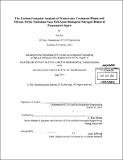The carbon footprint analysis of wastewater treatment plants and nitrous oxide emissions from full-scale biological nitrogen removal processes in Spain
Author(s)
Xu, Xin, Ph. D. Massachusetts Institute of Technology
DownloadFull printable version (23.82Mb)
Other Contributors
Massachusetts Institute of Technology. Department of Civil and Environmental Engineering.
Advisor
E. Eric Adams.
Terms of use
Metadata
Show full item recordAbstract
This thesis presents a general model for the carbon footprint analysis of advanced wastewater treatment plants (WWTPs) with biological nitrogen removal processes, using a life cycle assessment (LCA) approach. Literature on greenhouse gas (GHG) emissions and LCA are reviewed and the methodology employed in the analysis is discussed. Two selected WWTPs in Madrid, Spain, i.e. La Gavia and Boadilla, are analyzed and the carbon footprints are calculated, using GaBi software by PE-international. In quantifying the N₂O emissions from the biological nitrogen removal processes in the WWTPs, huge uncertainty on N₂O emission factor is identified and thus a comprehensive study on N₂O generation and emission is conducted. Different measurement strategies are investigated and an on-site aqueous N₂O measurement is carried out at Boadilla WWTP. Estimation of N₂O emission from the plant is given and compared with other calculation results. Recommendations on future measurement campaign are provided at last. The final results have shown that a big portion of the carbon footprints from the WWTPs is from the indirect emissions of CO₂, which is caused by the intensive energy consumption. However, the emissions resulting from the N₂0 in biological nitrogen removal processes cannot be ignored. Depending on different estimation methodologies, and the operational conditions that affect the N₂O production, the N₂O emission can range from 17% to 38% of the total carbon footprint of the WWTP.
Description
Thesis (S.M.)--Massachusetts Institute of Technology, Department of Civil and Environmental Engineering, 2013. Cataloged from PDF version of thesis. Includes bibliographical references (pages 95-102).
Date issued
2013Department
Massachusetts Institute of Technology. Department of Civil and Environmental EngineeringPublisher
Massachusetts Institute of Technology
Keywords
Civil and Environmental Engineering.